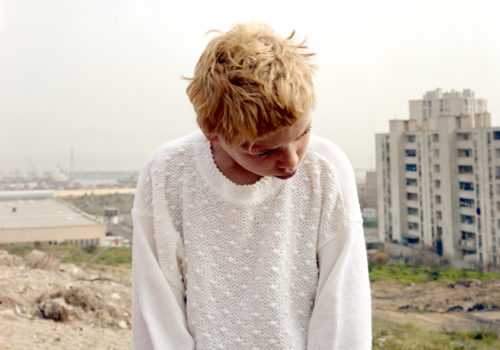Valérie Jouve’s photographs exude a powerful energy, as does she. Don’t try to talk to her about religion when she talks to you about humanity, sharing and values. This little lady will take you by the shoulder and explain how it has nothing to do with geopolitics, but rather with the love of one’s neighbor, something she wants to instill in the reality of daily life, creating a kind of utopia… Then you’ll understand: Jouve is an “engaged” artist, but engaged photographically rather than politically.
She builds up her images, and here at the Jeu de Paume in Paris, the idea of retrospective is called into question by the layout of the exhibition itself. Corps en Résistance offers visitors a five-act visit, with the first three offering instructions in how to understand her work. While a series of photographs usually studies an entire subject, Jouve’s approach is elemental; her work isn’t based on series, but rather on encounters.
The first two rooms are devoted to her “Personnages” (Characters), inviting viewers to take a journey through the urban world. “These characters are playing roles. I stop them in the street. One must understand the ‘of the image,’ from one photograph to the next. One has to realize what one thinks one is and what the camera is going to capture.” Her “characters” have a corporeal power, unlike her “Passants” (Passersby) or Her “Sortie de bureau” (Leaving the Office) which reveal a little bit of “density” while defining a certain mechanics of life.
The “Figures” and “Murs” (Walls) lead one to reflect on the city, while it gradually fades and lets itself be invaded by bodies. Starting from her early work, one will remember the dialogue she sets up between the figure and the landscape in her staged choreographies. And over time, she creates a distance with her subject, addressing the idea of territory which will lead her to experiment with film as well as photography.
In the third room we see her work in cinema. The images question the occupation of place rather than owning or inhabiting it. Jouve is faithful to the spaces she photographs, like this cold, brutal wall which ruins the sense of harmony. Then comes Traversée, a kind of tender road movie that passes through six Palestinian cities, from Jericho and Nablus to Jerusalem, a land with an undeniable Arabic heritage.
The final two rooms allow one to appreciate the magnitude of Jouve’s approach, which strikes a balance between cinema and photography. Blues is an installation made up of filmed sequences, photographs and audio recordings which trace the journey of the singer Tania Carl, who settled in Guatemala and with whom Jouve has been collaborating for several years. By bringing together these different visual and sonic elements, Jouve establishes a narrative sequence, a dialogue between different non-musical media, writing a piece of blues music featuring Tania Carl’s singular voice. We can feel her anger with society and her pride at belonging to a certain popular culture, a kind of manifesto which not only supports, but superimposes the images to the point of integrating them entirety. As in all her work, Jouve calls upon our imagination, playing with space and the echoes stirred by the confrontation of images, inviting us to project ourselves into a space of experimentation.
http://vimeo.com/131086246
EXHIBITION
Corps en résistance
Valérie Jouve
Prints for “Blues” series by Picto Lab
From June 2nd to September 27th, 2015
Jeu de Paume
1, place de la Concorde
75008 Paris
France
http://www.jeudepaume.org
















